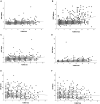The impact of upper motor neuron involvement on clinical features, disease progression and prognosis in amyotrophic lateral sclerosis
- PMID: 37822527
- PMCID: PMC10562695
- DOI: 10.3389/fneur.2023.1249429
The impact of upper motor neuron involvement on clinical features, disease progression and prognosis in amyotrophic lateral sclerosis
Abstract
Objectives: In amyotrophic lateral sclerosis (ALS) both upper (UMNs) and lower motor neurons (LMNs) are involved in the process of neurodegeneration, accounting for the great disease heterogeneity. We evaluated the associations of the burden of UMN impairment, assessed through the Penn Upper Motor Neuron Score (PUMNS), with demographic and clinical features of ALS patients to define the independent role of UMN involvement in generating disease heterogeneity, predicting disease progression and prognosis.
Methods: We collected the following clinical parameters on a cohort of 875 ALS patients: age and site of onset, survival, MRC scale, lower motor neuron score (LMNS), PUMNS, ALSFRS-R, change in ALSFRS-R over time (DFS), MITOS and King’s staging systems (KSS). Transcranial magnetic stimulation was performed on a subgroup of patients and central motor conduction time (CMCT) and cortical silent period (CSP) were calculated.
Results: We observed that patients with an earlier age at onset and bulbar onset had higher PUMNS values. Higher values were also associated to lower ALSFRS-R and to higher DFS scores, as well as to higher MITOS and KSS, indicating that a greater UMN burden correlates with disease severity. Conversely, we did not appreciate any association between UMN involvement and survival or markers of LMN impairment. Moreover, PUMNS values showed a positive association with CMCT and a negative one with CSP values.
Interpretation: Our results suggest that the burden of UMN pathology, assessed through PUMNS, has an important independent role in defining clinical characteristics, functional disability, disease progression and prognosis in ALS patients. We also support the role of TMS in defining severity of UMN involvement.
Keywords: Penn upper motor neuron score; amyotrophic lateral sclerosis; motor neuron disease; transcranial magnetic stimulation; upper motor neuron involvement.
Conflict of interest statement
VS received compensation for consulting services and/or speaking activities from AveXis, Cytokinetics, Italfarmaco, Liquidweb S.r.l., Novartis Pharma AG and Zambon. Receives or has received research supports form the Italian Ministry of Health, AriSLA, and E-Rare Joint Transnational Call. He is in the Editorial Board of Amyotrophic Lateral Sclerosis and Frontotemporal Degeneration, European Neurology, American Journal of Neurodegenerative Diseases, Frontiers in Neurology, and Exploration of Neuroprotective Therapy. NT received compensation for consulting services and/or speaking activities from Amylyx Pharmaceuticals, Italfarmaco and Zambon Biotech SA. He received research funding from the Italian Ministry of Health and AriSLA. He is Associate Editor for Frontiers in Aging Neuroscience. The remaining authors declare that the research was conducted in the absence of any commercial or financial relationships that could be construed as a potential conflict of interest.
Figures




References
-
- Devine MS, Ballard E, O’Rourke P, Kiernan MC, Mccombe PA, Henderson RD. Targeted assessment of lower motor neuron burden is associated with survival in amyotrophic lateral sclerosis. Amyotroph Lateral Scler Frontotemporal Degener. (2016) 17:184–90. doi: 10.3109/21678421.2015.1125502, PMID: - DOI - PubMed
-
- Fujimura-Kiyono C, Kimura F, Ishida S, Nakajima H, Hosokawa T, Sugino M, et al. Onset and spreading patterns of lower motor neuron involvements predict survival in sporadic amyotrophic lateral sclerosis. J Neurol Neurosurg Psychiatry. (2011) 82:1244–9. doi: 10.1136/jnnp-2011-300141, PMID: - DOI - PubMed

